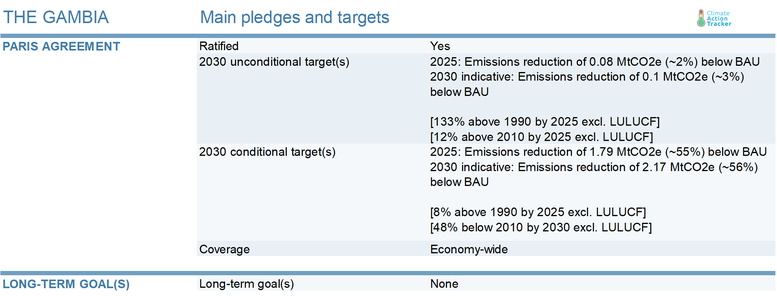Country summary
Overview
The Gambia is rare among the world’s developing countries in proposing an ambitious conditional emissions reduction target that would bend its emissions downwards. Deployment of renewables is taking off with a couple of large-scale solar PV projects planned in the near future. The impact of COVID-19 is still unclear and limited data availability adds further uncertainty to both historical and current policy projections. However, emission trends indicate that The Gambia will achieve its unconditional target, which the CAT rates as “1.5°C Paris Agreement Compatible.”
We expect Gambia’s greenhouse gas emissions in 2020 to be around 5.7-7.4% lower than in 2019. The COVID-19 pandemic is expected to have severe socioeconomic consequences for The Gambia. As with the rest of the world, short-term emissions have decreased due to the economic standstill. Heavily dependent on tourism, the country’s GDP growth is projected to decline by 2% to 3.1% in 2020 compared to a growth of 6% in 2019. In addition to international financial support, the Gambian government plans to boost its recovery with support for the production and construction industries to create additional jobs in the agriculture and real estate sectors.
One of the pillars of The Gambia’s strategy to achieve its emissions reduction targets is the uptake of renewable energy technologies. After a slow start, the Gambia is now rapidly increasing its renewable energy capacity with a total of 170 MW in solar PV projects in the pipeline for 2021-2025, with partial finance from the World Bank and the European Investment Bank.
At a time when countries should move away from fossil fuels, The Gambia has set targets to start oil extraction in the country by 2019 and to stop importing oil by 2025. In 2018, the Australian oil company FAR started drilling The Gambia’s first offshore well in 40 years and in 2019, the Gambian government signed another deal with BP to explore oil and gas off its coast.
The Gambia's Nationally Determined Contribution (NDC) aims to unconditionally reduce emissions by 2.4% by 2025 below business-as-usual (BAU) and, conditional on international financial support, aims for a target of a 55% reduction by 2025. This is within the range of what is considered to be a “1.5°C compatible” fair share of global effort under the CAT’s equity rating. This means that while The Gambia’s unconditional Paris Agreement climate commitment in 2030 allows the country’s total emissions to increase, it is consistent with holding warming well below 2°C, and limiting warming to 1.5°C, based on its historical responsibility and its capability.


According to our analysis, The Gambia will meet its proposed unconditional targets with currently implemented policies.
The government has recognised that the transition to an affordable sustainable energy system is a critical milestone for the country’s socio-economic development as dependence on imported fuel oil has become a burden on the Gambian economy. To ignite this transition, in 2013 The Gambian government enacted the New Renewable Energy law to implement a feed-in tariff for renewable energy sources, and to establish a renewable energy fund to promote the use of such sources.
To meet its conditional target and give confidence to international investors, the Gambian government announced, in its Sustainable Energy Action Plan, specific renewable energy and energy efficiency targets for 2020 and 2030, and declared the measures it would deploy to reach those targets. Since two large-scale solar PV projects are in the final stages of the tendering process and have partially received international finance, we have included the targets in the current policy projections.
The Gambia’s NDC also includes reductions in the forestry, land use and agriculture sectors. The Gambia plans to realise these reductions partially through afforestation. In 2018, it launched a large project to restore 10,000 hectares of forests, mangroves, and savannas. It will also replace flooded rice paddies with dry upland rice fields and promote adoption of efficient cookstoves to reduce the overuse of forest resources, conditional on international support.
Further analysis
Latest publications
Stay informed
Subscribe to our newsletter




